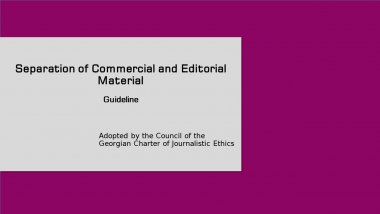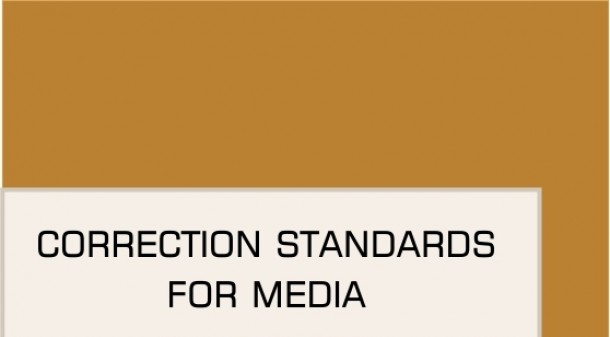Basically, all types of media outlets allocate advertising time and place – banners or commercials are entirely different from a journalistic material in terms of form and contents, therefore, it is less likely that anyone will perceive them as editorial material. In contrast, problematic is the material that does not differ from journalistic content, for example, it has the form of an article or footage is prepared, etc. At such time the audience may easily believe that the information provided with no proper labeling has been checked by the editor, for example, a product is really the best.
Consequently, instead of using confusing symbols, it is important to indicate that the material is an advertisement.
Basic
rules:
• Media organizations must ensure editorial independence from commercial influence. The influence means changing the airtime or publication timeframes, idea, a footage storyline, respondents, presenter’s behaviour, shooting angle, location or other key details as desired by the customer.
• It should be clear to the public that they are receiving information of commercial content.
• Any material prepared and published as commercial content must be strictly distinct from the editorial material. It must be accompanied by a proper labeling in an easily detectable place and form.
• Any material without a relevant marking shall be considered as a content of the editorial responsibility.
• The editorial office should have in place a policy for distinguishing between advertising and editorial content, which must become the basis of signing agreements with advertisers or service purchasers. In addition, advertising and editorial departments should be clearly separated.
• When promoting commercial content within the scope of any advertising agreement, no further editorial support should be provided for a company or a product.
Financed
content
It is a common practice to publish content in the form of an article that is paid for commercially, which can misinform readers because of the lack of an appropriate marking.
• Contents developed in online and printed media based on an agreement should be accompanied by an indication of funding in an easy-to-read place and manner. The labels such as "Partner Content", NS, R, "Associate’s Material", etc. are confusing to the reader. It is better to apply the labeling like "Advertising"/"Commercial Article", "Advertising Page". It is not recommended to indicate on the last page of a newspaper or a website that certain pages / columns are funded. The marking must be added to an article itself.
• The editorial office should be transparency-oriented. If it is impossible to identify a customer in a commercial content, the editor should clearly indicate the client.
• If the content provided by the customer contains specific accusations against another person, or it is obvious that the purpose of the content is to discredit a person, the editorial office must make a decision on the publication of such content based on their editorial policy.
• As for broadcasters, advertising a product or a service in a news programme is both unethical as well as illegal. A part of the international media has such restrictions regarding the programmes that provide the public with news about business and economics.
• When placing an advertising content or footage, or selling the airtime in a programme that is not a news programme, the broadcaster must inform the audience that the material is commercial. Subtitling can be used for this purpose.
Product
placement
Product placement is the inclusion of a product within a programme for a commercial purpose, for example, placing a banner, using branded items, etc.
• According to the legislation, product placement is allowed only in feature films, television films, soap-operas, film episodes (except for documentaries), sports and entertainment programmes (except for children's programmes), lotteries, gambling games, goods/services provision as a prize free of charge or without economical benefits.
• In such programmes products can be placed, but under relevant rules - it is impermissible to promote a product and its advantages and encourage public to purchase it. No specific address, product price, discount, slogan or other details should not be indicated, as they are a part of advertisement. • It is prohibited to place medicines and medications that are issued under prescription.
• It is not permitted a presenter to persuade viewers to purchase a product by referring to his/her own experience, for example, "I've been using this shampoo for a month and I'm excited by the result," "I advise you to buy this juice. My daughter starts her morning with it. It’s a completely natural product. "
• A positive assessment provided by a presenter or encouraging viewers to buy the product is particularly unacceptable and unethical when it comes to health. The presenter’s persuasive promotion of medications, self-care products, nutrition, and other products may lead to deplorable consequences.
Sponsorship
Sponsorship is a direct or indirect funding or co-financing of the preparation of a programme or a live broadcasting of a programme with a view to promoting a sponsor’s name, trademark, image, and activities. Sponsorship should be strictly distinct from advertising because it directly funds particular media content.
• Similarly to product placement, the sponsor must not distort contents of the funded material.
• Sponsorship of information-political programmes must be prohibited, as well as of those which are related to consumer rights, electoral campaigns.
• The audience should clearly identify the sponsor by means of his/her name, commodity or other identifying marking at the beginning, in the course and / or at the end of the programme.
• Sponsorship must not include the invitation to purchase a product or a service.
• Content and rubrics that provide reviews or advice on various products and companies cannot be sponsored by organizations whose products or services are likely to be reviewed.
Participation of
journalists in advertising
• With the view to ensuring impartiality, a journalist or a
presenter of news programmes, public-political and pre-election
debates may not be permitted to participate in advertising or
teleshopping.• The same standard must be applied to commercials disseminated by broadcasting or other media platforms.






